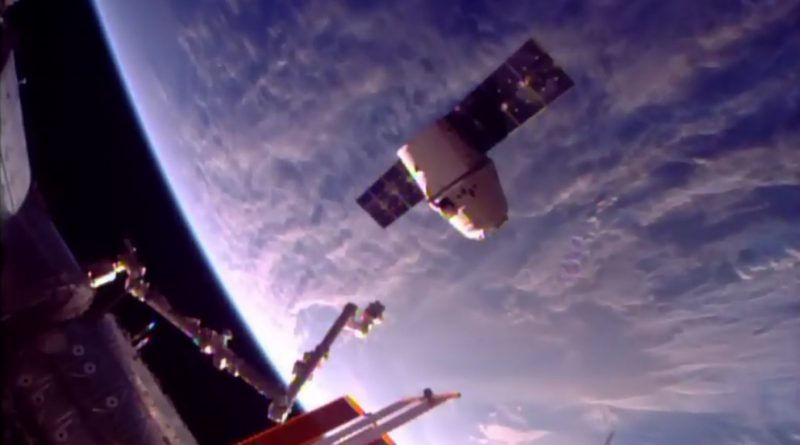SpaceX Dragon Splashes Down with Critical Space Station Science
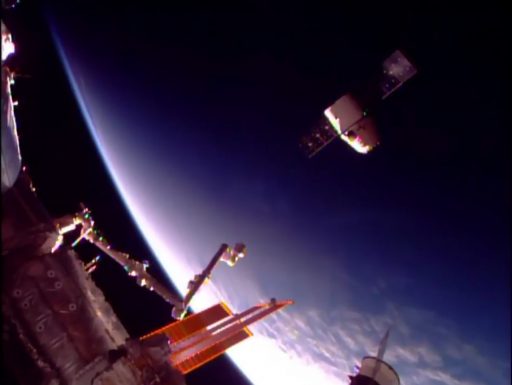
The SpaceX Dragon made a successful homecoming after almost 34 days off the planet on Sunday, capping a successful mission that facilitated the shipment of world-class science to the International Space Station and the return of research gear and samples eagerly awaited by scientists to finally understand the structure of a protein implicated in Parkinson’s disease, reveal how long-duration space flight affects blood vessels in the brain and eyes, and examine bio-engineered lung tissues grown on ISS.
The Dragon SpX-12 spacecraft was unberthed from its Earth-facing port at the orbital laboratory Saturday night and was set free at 8:40 UTC on Sunday, breathing fire again after sitting idle at ISS for nearly 32 days. Firing its thrusters, Dragon began moving away from the orbiting complex with some 1,720 Kilograms of return cargo loaded into its pressurized cargo compartment.
A rocket-powered braking maneuver placed the Dragon on course to a blazing re-entry, followed by a parachute-assisted descent toward a 14:14 UTC splashdown in the Pacific Ocean, off the coast of Baja, California.
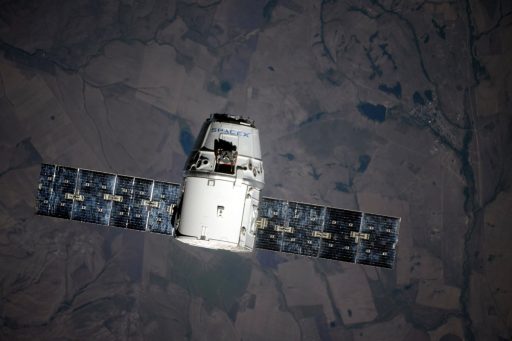
The twelfth regular Dragon mission – the last in the original Commercial Resupply Services Contract with NASA – ran like clockwork up to the craft’s departure from ISS, beginning on August 14 with liftoff from Florida atop a Falcon 9 rocket. Loaded with 2,910 Kilograms of cargo, Dragon enjoyed a smooth ten-minute ride into orbit atop the two-stage rocket with the vehicle’s first stage making a powered return to the Cape for touchdown at Landing Zone 1, giving SpaceX another booster in excellent condition for future re-use.
Separated from its launch vehicle, Dragon headed off on a two-day rendezvous with ISS culminating in a straight-up approach to the complex on August 16 with a robotic capture marking Dragon’s arrival at its orbital destination. The craft was berthed to the Harmony module later that day and a very eager ISS crew pushed into hatch opening procedures the same day and also managed to complete a good chunk of the internal cargo transfer work within the first 24 hours of Dragon’s tenure at ISS.
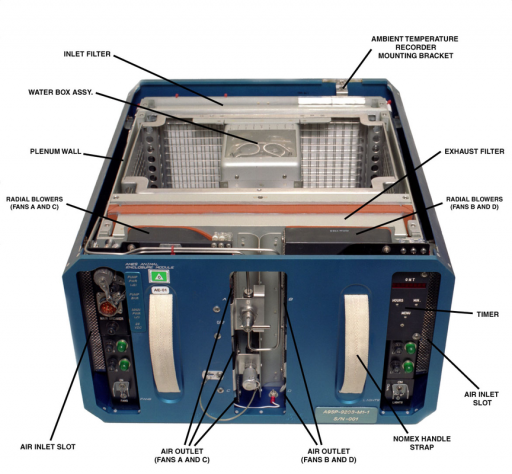
The Dragon SpX-12 spacecraft was loaded with 1,652 Kilograms of pressurized cargo, broken down in 916kg of research gear, 339kg of maintenance hardware, 220kg of crew supplies and 83kg of spacewalk and computer equipment. The mission set a record for the most amount of science cargo delivered by any previous ISS visiting vehicle.
Taking a ride aboard the Dragon were two groups of Mice – one aboard the Rodent Habitat under U.S. operation and the other in Japan’s Mouse Habitat Unit, participating in a study of musculoskeletal changes caused by extended stays in microgravity. Rodent Research 9 – the sixth RR flight to ISS – combines three studies into one experiment, looking at how long-duration space flight affects the structure of cerebral arteries in the brain, studying micro-vascular and tissue remodeling in the eye – a cause of space-induced visual impairment, and determining the scope of knee and hip joint degradation during long-duration space flight.
The 20 mice – unlike some of their predecessors – were lucky enough to have a return ticket and were among the time-critical items packed into Dragon on Saturday before its hatch was closed.
>>Dragon SpX-12 Cargo Overview
The SpX-12 mission also delivered to ISS a Spaceborne Supercomputer for a critical technology demonstration mission that aims to validate the design of an onboard computer for the spacecraft of the future. At present, computers used on crewed and uncrewed spacecraft are several generations behind modern machines on Earth and feature heavy radiation shielding.
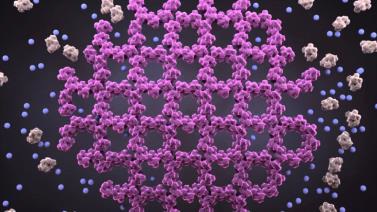
The Spaceborne Computer experiment will show, over the duration of one year, a software-driven technique to protect it from radiation – potentially enabling a generation of light, highly-capable computers that can support the autonomy needed by missions venturing out into the distant reaches of the solar system.
Another high-profile study on the SpX-12 mission was Protein Crystal Growth 7 – exploiting the unique environment found on ISS to grow pristine crystals of a protein shown to play a major role in Parkinson’s disease. Protein crystals grown in space are much larger and more uniform than those produced under the influence of gravity which allows their full structure to be determined via laboratory methods on Earth, providing insight into their function and helping in the development of inhibitor therapies.
Other experiments riding up on Dragon aimed to grow bio-engineered lung tissue, track how potentially harmful microbes spread in space, and examine how plants protect themselves from stress factors encountered in space; also aboard the spacecraft were new plant pillows for the Station’s Veggie facility to continue working on in-space cultivation techniques needed for missions to distant targets.
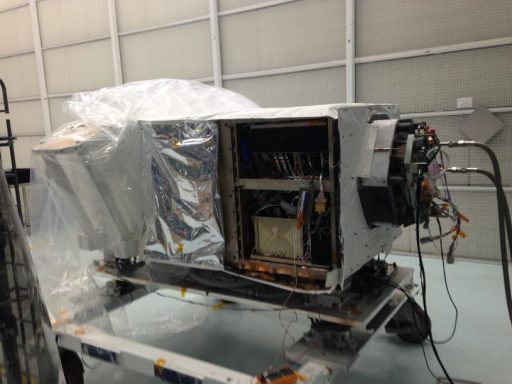
Bolted into the Trunk Section of the Dragon was a 1,250-Kilogram particle detector package to expand the Space Station’s role as an orbiting astrophysics laboratory. CREAM – the Cosmic Ray Energetics and Mass Instrument – took up residence outside the Station’s Kibo Module from where it will measure incoming particles at ultra-high energies, further up in energy than can be measured by the Alpha Magnetic Spectrometer 2, the Station’s dark matter hunter.
Researchers hope to use data from CREAM to help explain some of the peculiarities in the cosmic energy spectrum – in particular an unexplained decline in the observed spectrum where particle theory would not predict such a decrease, a question that has been puzzling scientists for decades.
>>Article: CREAM Installed on ISS
With Dragon’s mission winding down, the ISS crew placed the final time-critical return items into the pressurized compartment of the spacecraft before closing its hatch and buttoning up the hatchway of the Harmony module for an overnight unberthing by releasing 16 bolts and opening capture latches. Once free from Harmony, Dragon was maneuvered into its release position by ROBO controllers on the ground in the overnight hours to set up for an early release of the spacecraft.
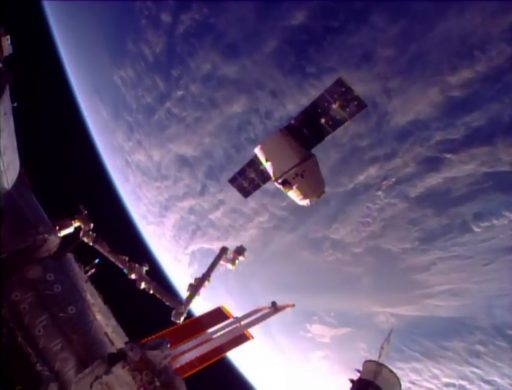
Setting up shop in the Station’s Cupola was ESA Astronaut Paolo Nespoli, the prime robotics operator in charge of releasing the spacecraft, backed up by Expedition 53 Commander Randy Bresnik who handled communications with the ground and commanding of Dragon via the COTS UHF Communications Unit. Snares within the arm’s latching end effector opened up at 8:40 UTC, setting Dragon free for its return journey.
Paolo Nespoli retracted Canadarm2 to a safe distance and Dragon recovered from Free Drift, pulsing its Draco thrusters three minutes after release to initiate a slow opening rate down the Station’s R-Bar, or radial vector. Another separation maneuver accelerated Dragon down the R-Bar and out of the Station’s Keep Out Sphere followed by the third and largest separation burn that set Dragon on a course to pull out in front of ISS and open a gap of around 150 Kilometers before the deorbit burn.
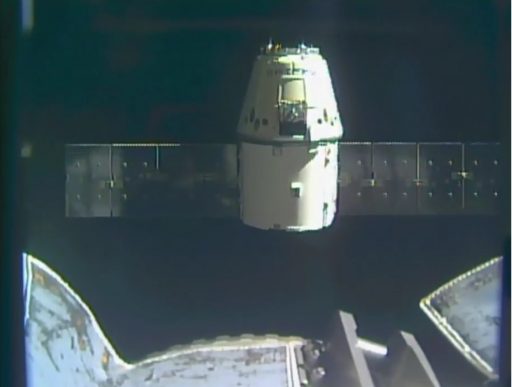
With Dragon confirmed on a safe path away from ISS, NASA ended its involvement in the mission with SpaceX having the responsibility of getting Dragon safely back to Earth and ship return cargo back to NASA.
Dragon fired up at 13:24 UTC on a deorbit burn of just under ten minutes to slow by some 100 meters per second and transition from an orbital flight path to a sub-orbital arc intercepting the atmosphere at a pre-determined location from where the craft could reach its parachute opening target. Around four minutes before hitting the atmosphere, Dragon was to jettison the expendable Trunk Section which is not holding any external disposal payloads on this mission and was facing a fiery re-entry as it lacks the protection of a heat shield.
Encountering the dense atmosphere, Dragon’s PICA-X heat shield had to endure temperatures up to 1,600 degrees Celsius and Dragon was programmed to constantly modify its lift to optimize the flight path toward the planned parachute opening target – having shown good accuracy since its very first landing from an ISS mission.
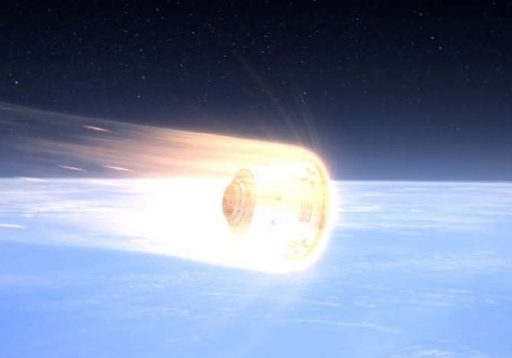
Friction in the atmosphere slowed Dragon to a subsonic speed of 240 meters per second at which point two drogue chutes deployed some 13.7 Kilometers in altitude to further reduce the vehicle’s speed for the deployment of the three large main chutes. Under the three mains, Dragon transitioned to a vertical descent and slowed to a landing speed of around 20 Kilometers per hour for splashdown around 340 Kilometers west of San Diego.
Dragon’s landing started the typical race against the clock to ensure time-critical payloads make it to NASA within 48 hours of touchdown. Loaded onto a ship, Dragon will be transported to the Port of Long Beach where time critical items are removed and shipped to their home institutions while Dragon continues by road to SpaceX’s McGregor test site in Texas where the remaining cargo items will be removed followed by post-flight processing to allow the Dragon spacecraft to enter refurbishment for a potential future flight.
Closing out its third mission to ISS this year, SpaceX is moving toward the Dragon SpX-13 mission currently looking at a tentative launch target No Earlier Than December, depending on the Station’s cargo needs as well as other scheduling concerns on the ISS side.

